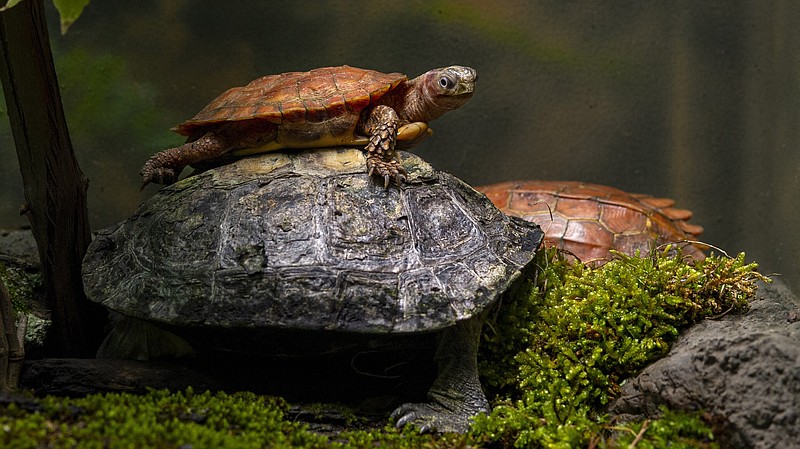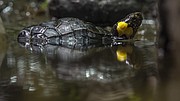If life moves at a slower pace at the Tennessee Aquarium this summer, there's a turtle-y good reason.
Last week, Aquarium officials cut the ribbon on a new "Turtles of the World" gallery that showcases more than 30 turtle species and efforts by everyone from scientists to homeowners to preserve these reptiles for future generations.
The Aquarium already is home to the largest freshwater collection of turtles in North America. The new gallery focuses attention on the various species and the illegal practices that are putting them at risk.
"We want to convey four ideas with this gallery: that turtles are cool, they're in trouble, what we're doing to help them, and what you can do," says Jeff Worley, manager of exhibit services.
Last month, the Aquarium announced its participation in the Association of Zoos and Aquariums' Saving Animals From Extinction program, or SAFE. The Chattanooga facility is one in a sprawling network of zoos, aquariums, universities, government agencies and conservation nonprofits taking part in SAFE, focusing on ending illegal trafficking of turtles. Dave Collins, the Aquarium's director of forests and animal behavior, serves as the program's leader and coordinator.
2020 had already been declared the Year of the Turtle by a number of zoological institutions and conservation organizations. The Tennessee Aquarium is marking the celebration with the new gallery, a Turtle Trail, an Imax movie and special programming during the year.
'TURTLES OF THE WORLD'
Open since Friday, the "Turtles of the World" gallery is housed in a new hall in the River Journey building. Upon entering, visitors encounter four large exhibits depicting habitats found in the southeastern United States and Southeast Asia. Because of their abundance of species, these regions are considered by scientists as hot spots of turtle diversity.
The two largest habitats in this first group of exhibits have water features. All of them incorporate enormous glass panels that offer unobstructed views of their residents as they clamber over and under vegetation and bask or dive beneath the surface.
Later, visitors will see an exhibit full of sinuous snake-necked turtles. Only found in Australia and other South Pacific islands, these unusual-looking turtles are keen swimmers and have serpentine necks so long they can't be retracted into their shells.
The centerpiece of the new gallery is a working turtle nursery, where guests can watch Aquarium herpetologists and animal-care specialists as they tend to dozens of hatchlings. This huge laboratory will host special programs and features sliding panels so animal experts can interact with guests while they work.
The adorability factor is high here, but these tiny turtles represent some of the most imperiled species on the planet. Their presence here fulfills an important goal of the new gallery to raise awareness of the many challenges turtles face in the wild.
30-second science lesson
Turtles› Habitat: Water. Most are found in water or living near it.› Diet: Carnivorous, omnivorous and herbivorous.› Shell shape: Flat to reduce drag in water.› Feet: Webbed to aid in swimming.Tortoises› Habitat: Land. Most are terrestrial.› Diet: Herbivorous (a few are omnivorous).› Shell shape: Domed to aid in defensive protection.› Feet: Short and sturdy. Strong legs are needed to dig.Terrapins› Habitat: Brackish, where water meets land.› Diet: Carnivorous, herbivorous.› Shell shape: Oblong, between domed and flat.› Feet: Webbed, with strong broad claws to climb out of water.Source: TheSuperFins.com
"The Aquarium has always been a place you can come enjoy and learn about turtles because they're something we've always highlighted," Collins says. "The new gallery brings some new ideas in and showcases some new turtles we have an opportunity to exhibit, including some of the rarest in the world."
The hatchlings being exhibited were confiscated from the turtle trafficking trade or were sent to the Aquarium through a partnership with the South Carolina-based conservation group Turtle Survival Alliance and other partners. Many of these miniature turtles are Southeast Asian species that are endangered or critically endangered and are being kept as "assurance colonies" against the possibility of extinction.
"Turtles of the World" arrives just in time for spring break, and its layout features a wealth of design touches made with younger guests in mind. After visiting kiosks to color their own turtles using touchscreens, they can learn about four inspiring turtle "success stories." Another interactive game requires some strategic thinking to make decisions that turn a home into a haven for turtles.
Naturally, no trip through the Aquarium is complete without a picture or two, and "Turtles of the World" has a pair of memorable selfie (shellfie?) opportunities. Guests will feel positively tiny posing beside a life-size replica for a shell of Stupendemys, a now-extinct turtle the size of a small car. Then, visitors can do their best hatchling impersonation by crouching inside hollowed-out "eggshells" in an enormous turtle nest.
When the Aquarium team began designing the new gallery, they mapped out two key missions: to inspire a love of turtles and an understanding of what it will take to keep them safe. Whether it's successful conservation efforts or just giving guests a chance to watch a tortoise hatchling snack on its lunch, "Turtles of the World" should achieve both its aims, Collins says.
"Turtles can live as long as we do, but no matter if they're 40 years old or just a few months old, they're relatable animals," he says. "They have these big eyes you can look into, and there's just something ageless about them. When you gaze into a turtle's eyes, you really feel like you're looking back in time."
The opening of a new turtle-centric gallery is the latest event tied to the Year of the Turtle celebration, but the focus on chelonians is readily apparent throughout the River Journey and Ocean Journey buildings. Among the highlights is the chance to observe a large green sea turtle gliding through the waters of the Aquarium's Secret Reef exhibit.
TURTLE TRAIL
As they explore, guests will encounter colorful, stylized "blazes" in galleries that mark the presence of turtles in an exhibit. This Turtle Trail shines a light on the Aquarium's many turtle and tortoise residents and emphasizes its superlative as home to the largest collection of freshwater turtles in North America.
For a more thoughtfully interactive adventure along the Turtle Trail, visitors can request a trail guide from the visitor services desk in the River Journey building. Available as a pocket-size pamphlet or download, the guide is filled with fun facts and questions about turtles' life history.
'TURTLE ODYSSEY 3D'
Across the street, the experience continues at the Imax 3D Theater. Here, daily screenings of "Turtle Odyssey 3D" follow Bunji, a baby green sea turtle, as she travels more than 1,000 miles after hatching on the shores of the Great Barrier Reef through the South Pacific Ocean. Along the way, viewers will meet many other colorfully charismatic residents in these life-filled waters and learn more about the efforts of conservationists to protect Bunji and the rest of her kind.
Contact Lisa Denton at ldenton@timesfreepress.com or 423-757-6281.

